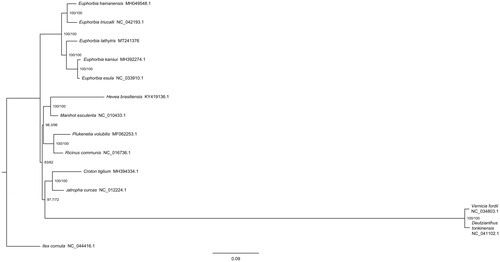Abstract
Euphorbia lathyris is a biennial herb plant in China. The seed is commonly used in well-known traditional Chinese medicine, and it has anti-tumor, p-glycoprotein and tyrosinase inhibitory activities. The length of circular chloroplast genome was 162,571 bp, containing a large single-copy region of 91,946 bp, a small single-copy region of 17,301 bp and two inverted repeat regions of 26,662 bp. The chloroplast genome contained 128 genes, including 85 protein-coding, 8 rRNA, and 35 tRNA genes. Phylogenetic tree analysis showed that E. lathyris, E. kansui and E. esulaare are closely related to each other.
Euphorbia lathyris is a biennial herb of Euphorbia (Euphorbiaceae). The dried seed of E. lathyris is used in traditional Chinese medicine and listed in the Chinese Pharmacopeia. It is widely applied to treat with edema (Chinese Pharmacopeia Committee Citation2010). Modern pharmacological experiments showed that E. lathyris had anti-tumor, p-glycoprotein and tyrosinase inhibitory activities (Appendino et al. Citation2001, Citation2003; Masamoto et al. Citation2003; Wang et al. Citation2011). In addition, E. lathyris seeds have a high oil content, and can be used for biodiesel production (Wang et al. Citation2011). Plant species are diverse and complex in Euphorbiaceae. In the present study, we characterize the complete chloroplast genome of E. lathyris and provide basic data for studying the phylogenetic relationships in Euphorbiaceae.
The fresh leaves of E. lathyris were sampled from Shaanxi Institute of International Trade and Commerce (34°29′N, 108°72′E; Shaanxi, China), and the voucher specimen (ZY190201) was deposited in the herbarium of the Xi’an Botanical Garden. Genomic DNA was extracted from the fresh leaves using the modified CTAB method (Doyle and Doyle Citation1987). Total DNA was used for the shotgun library construction and the subsequent high-throughput sequencing on the Illumina HiSeq 2500 Sequencing System.
After quality-trimmed and assembled using MITObim v1.8 (Hahn et al. Citation2013) with the reference sequence of Euphorbia esula (GenBank: NC_033910.1). The genome was annotated using software Geneious v9.0.2 (Biomatters Ltd., Auckland, New Zealand) by aligning with the reference chloroplast genome. The circular plastid genome map was completed using the online program OGDRAW (Lohse et al. Citation2013). The annotated chloroplast genome sequence has been deposited into the GenBank with the accession number MT241376.
The total plastome length of E. lathyris was 162,571 bp, with large single-copy (LSC, 91,946 bp), small single-copy (SSC,17,301 bp), and two inverted repeats (IRa and IRb; 26,662 bp each). The overall GC content was 35.7% (LSC: 32.8%; SSC: 30.5%; IRs: 42.4%) and the chloroplast genome contained 128 genes, including 85 protein-coding, 8 rRNA, and 35 tRNA genes.
In order to investigate the phylogenetic relationship of E. lathyris, the phylogenetic tree was constructed with MEG6 (Tamura et al. Citation2013) based on 12 complete chloroplast genome sequences of Euphorbiaceae and Ilex cornuta (Aquifoliaceae) (GenBank:NC_044416.1) as an outgroup (). The results indicated that several plants of Euphorbia were placed as a branch, and E. lathyris has a close relationship with E. kansui and E. esula.
Disclosure statement
No potential conflict of interest was reported by the author(s).
Data availability statement
The data that support the findings of this study are openly available in National Center for Biotechnology Information] at [https://www.ncbi.nlm.nih.gov/], reference number [MT241376].
Additional information
Funding
References
- Appendino G, Porta CD, Conseil G, Sterner O, Mercalli E, Dumontet C, Pietro AD. 2003. A new p-glycoprotein inhibitor from the caper spurge (Euphorbia lathyris)). J Nat Prod. 66(1):140–142.
- Appendino G, Tron GC, Jarevång T, Sterner O. 2001. Unnatural natural products from the transannular cyclization of lathyrane diterpenes. Org Lett. 3(11):1609–1612.
- Chinese Pharmacopeia Committee. 2010. Phamacopoeia of the People’s Republic of China. Beijing: Chinese Medical Science Press.
- Doyle JJ, Doyle JL. 1987. A rapid DNA isolation procedure for small quantities of fresh leaf tissue. Phytochem Bull. 19:11–15.
- Hahn C, Bachmann L, Chevreux B. 2013. Reconstructing mitochondrial genomes directly from genomic next-generation sequencing reads: abaiting and iterative mapping approach. Nucleic Acids Res. 41(13):e129–e129.
- Lohse M, Drechsel O, Kahlau S, Bock R. 2013. OrganellarGenomeDRAW – a suite of tools for generating physical maps of plastid and mitochondrial genomes and visualizing expression data sets. Nucleic Acids Res. 41(Web Server issue):W575–W581.
- Masamoto Y, Ando H, Murata Y, Shimoishi Y, Tada M, Takahata K. 2003. Mushroom tyrosinase inhibitory activity of esculetin isolated from seeds of Euphorbia lathyris L. Biosci Biotechnol Biochem. 67(3):631–634.
- Tamura K, Stecher G, Peterson D, Filipski A, Kumar S. 2013. MEGA6: molecular evolutionary genetics analysis version 6.0. Mol Biol Evol. 30(12):2725–2729.
- Wang R, Hanna MA, Zhou WW, Bhadury PS, Chen Q, Song BA, Yang S. 2011. Production and selected fuel properties of biodiesel from promising non-edible oils: Euphorbia lathyris L., Sapiumsebiferum L. and Jatrophacurcas L. Bioresource Technol. 102(2):1194–1199.
- Wang S, Wang X, Su X, Zhang M, Dong M, Shi Q. 2011. Inhibitory effect of lathyranediterpen factors from Euphorbia lathyris on the proliferation of gynecologic cancer cells. Chin Pharm Bull. 27(6):774–776.

